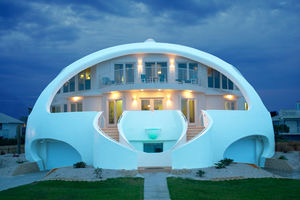Monolithic dome homes, as the name would suggest, are formed in one continuous dome structure. Until the 1970’s they were primarily cast in concrete over a form which was subsequently removed.

Since then, with the help of an innovation by David B. South and his brothers, monolithic dome construction has been revolutionised and most structures are now built using an airform.
The airform is designed and manufactured specifically for each project. It is inflated in position and the structure is constructed from the inside!
Wierd, I know.
Monolithic Dome Homes: The Construction Process
Dome construction begins by pouring a concrete ring beam foundation. This contains steel reinforcement and starter bars which the reinforcement in the dome itself will tie into. The ground floor can be poured at the same time as the beam or after the dome structure is complete.
A PVC coated airform is manufactured in the shape of the finished dome design and is fixed to the ring beam foundation. It is inflated with fans which run until the structure is complete.
When the airform is fully inflated work commences inside the bubble. First, Polyurethane (PU) foam, which acts as insulation, is sprayed onto the inner surface of the airform. As it sets hangers are embedded in the foam and steel reinforcement is fixed onto the hangers and tied back into the ring beam starter bars.
Once the reinforcement is fixed in place, a sprayable concrete known as Shotcrete is fired onto the foam and the reinforcment and sets in position.
The airform is left in place over the dome and acts as a vapour barrier and protection for the Polyurethane foam against Ultra Violet radiation (we should be so lucky!). The outside of the dome needs coating and a range of materials can be used from stone, render, tiles and metal cladding to elastomeric or ceramic paints.
Window, doors and other openings are cut into the dome and floors and other internal work can get underway.
 Advantages
Advantages
- High structural strength – Suitable as hurricane shelters.
- Reduced wind loading due to the aerodynamic shape.
- Domes encompass the largest volume within the smallest surface area of any building shape which results in:
-
- Less materials.
-
- Energy efficient with lower running costs – Lowest possible surface area for energy to escape.
-
- Reduction in external noise infiltration.
-
- A lighter structure than a box shaped counterpart using the same materials.
- Internally the dome shape allows an even distribution of heat, light, and sound.
- The structure of monolithic dome homes have a high thermal mass which is the ability to absorb and store heat. This reduces heating requirements in the Winter and cooling in the Summer.
 Disadvantages
Disadvantages
- This is not a common home building method in the UK and as such extra effort will be required with neighbours, planning, building control, lenders, insurance providers, warranty providers and during construction. Costs and time will increase as a result.
- Impractical shaped rooms – Furniture and fittings are generally designed for box shape spaces and may be difficult to position resulting in wasted space.
- Limited resale options.
- Specialist skills, equipment and materials are required.
- Concrete uses a lot of energy and produces a lot of Carbon Dioxide in its manufacture, although the industry is doing its best to improve things wherever it can.
- External finishes are often cited as a problem with monolithic domes and whilst there is a need to protect the airform and the PU from damage, deterioration and exposure, many of the cladding solutions have fallen short, or are expensive. Monolithic are aware of the importance of an effective covering and are constantly improving their techniques.
 More Information
More Information
The best place to go for information on monolithic dome homes is the Monolithic Dome Institute in Texas. It is the educational branch of group of companies who use this technique known simply as ‘Monolithic’. The Institute produces books, manuals and holds regular workshops for people who want to learn more or build their own.
They produce books, manuals and other material on the technique and if you are really interested you could even have a holiday in Texas and attend one of their workshops.
Find out about Geodesic Domes.
Return to Dome Homes.
Return to The Self Build Guide Home Page from Monolithic Dome Homes
